This bike is power and has a ton of features that I think you'll love. So sit back, relax, and hold on... hugs Peter
Hi everybody it's Peter and I'm here at Jim Gilbert's Power Sports, where we are going to talk about an in-depth review of the Kawasaki Ninja, ZX-6R also known as the Ninja 636. This thing is the stuff that dreams are made of and I know because as a little kid I dreamed about owning this bike. So in this review what we're gonna do is we're gonna go over some of the things that make this bike amazing, but we're also gonna be real about it. We're gonna talk about why it may not be right for you. This is not a bike I recommend for beginners and I know that there'll be people filling the comments, telling me, well I had a bike like that when I was a beginner and I'm fine. And that's great, it's still not a bike I would recommend to beginners.
We'll talk about why, what makes it really great, what makes it kind of a compromised bike because there are some things that you can't do as well on this bike. So for someone like me, I grew up dreaming of a bike like this and I will probably never own one. That doesn't mean I haven't ridden one, that doesn't mean I wouldn't maybe like to own one. And we'll talk about some of the options in the lineup and it kind of gives us some hint about the Kawasaki ZX-4R and ZX4-RR, which are similar to this, but sort of downsized engine and also a bike that really intrigues me. So let's go going on with this review and like I said, we're gonna try to cover the cool stuff and be real about it and hopefully you guys can respect that. If you wanna know more about this bike at this point, we are at Canada's largest volume Kawasaki dealer.
This is the only one that we have in stock. So I don't know if we can order more of what the story is with that, but right now this is sort of a one of one. I will come back to your comments and questions with future videos to answer more and more of what I can. But if this one sells, I can't promise how soon I'll do that. So make sure if you have questions, things you wanna know about it, let me know in the comments and hit subscribe cuz I'll do my best to come back to it as often as we can. So let's get going with the review. So I'm gonna start with something that may seem basic to you who are really big fans of this bike, but we still have people that come in and see this as a 6 36 cc motorcycle and compare it to the Ninja 650 which has more displacement and they just sort of wonder what the difference is.
Well the reality is this is a race bike for the street. Everything about this is designed to be a race bike. The riding position, which we're gonna show you in a second, all of the components. And the bigger difference is, although this is 636 cc, it is a four cylinder motorcycle where the Ninja six 50 is a two cylinder motorcycle. This has significantly more power. It is faster revving, it is higher revving, it is a completely different animal. But if you like the styling of this and you want something that's a little bit more comfortable, a little bit easier on your insurance dollars and easier to ride overall than Ninja 650 is there for exactly that reason. That's a bike that I've recommended to all kinds of people. This is the pinnacle of what can be done. And if you've ever driven a very, very, very high performance car like the top of the line Porsches or an exotic car or you know I drove a 700 horsepower Corvette, you find that there's a line, some of these cars kind of become less drivable every day, even though what makes 'em great for the track makes them great for the track.
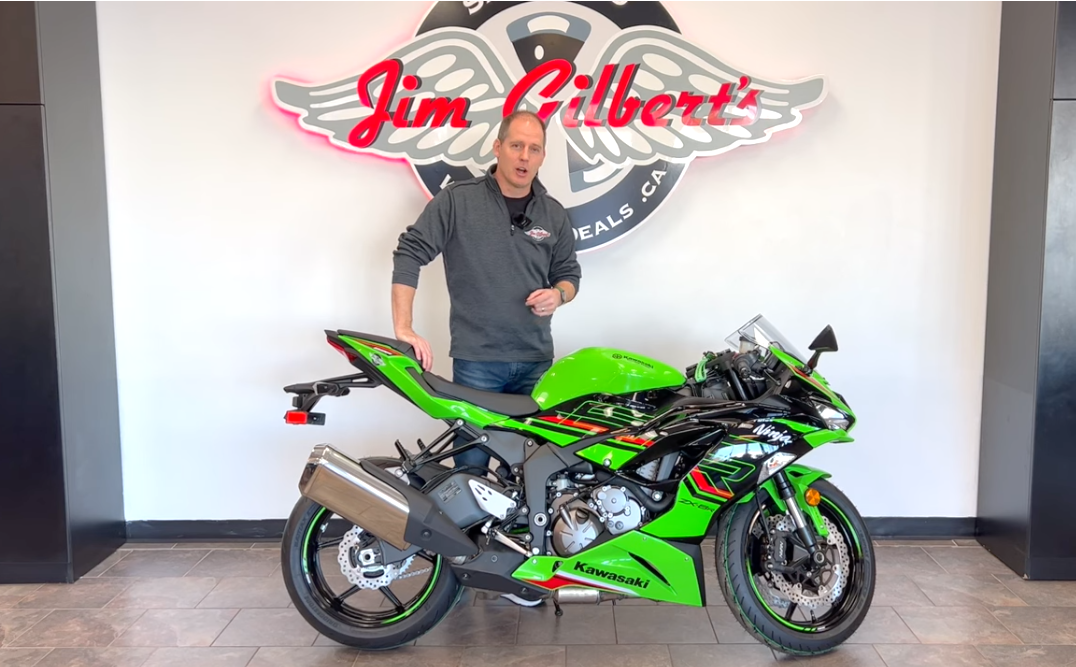
So we're gonna talk about some of those features in here, but the first thing I'm gonna do is gonna sit across it because as I sit across it, you're gonna see that this is a different riding position and it may or may not be right for you. So when you approach this bike from the back, it's got a nice small tail section, big wide tire, but you really notice kind of the width of the tank and that's something you, you don't really see from the side, but you do see from the back. And that's again because it's covering those four cylinders that are in line four here. So as I jump across here, I'm about six feet tall, I think I have a 32 or so inch in sea, I'm gonna put the kickstand up for now. This is my most upright seating position that I can find.
I'm against the tank and you can see it is way leaned over. Now the benefit of this is you can tuck back on the seat and I won't, can't do it without uh, driving. You can really tuck in right against this um, the tank here and the tank actually dips away so the curvature of your helmet can actually tuck into that area. There you've got the windscreen here that's all about aerodynamics. Now what you're gonna find in everyday driving with a seating position like this is that obviously there's a lot of weight on your hands and it's a lot of pressure. So again, as an everyday driver there are compromises here. But as a race bike, again the ability to have your hands in tight kind of angled back a little bit more than they would be on, you know, other road or more road focus bikes allows you to tuck in for both aerodynamics and for control.
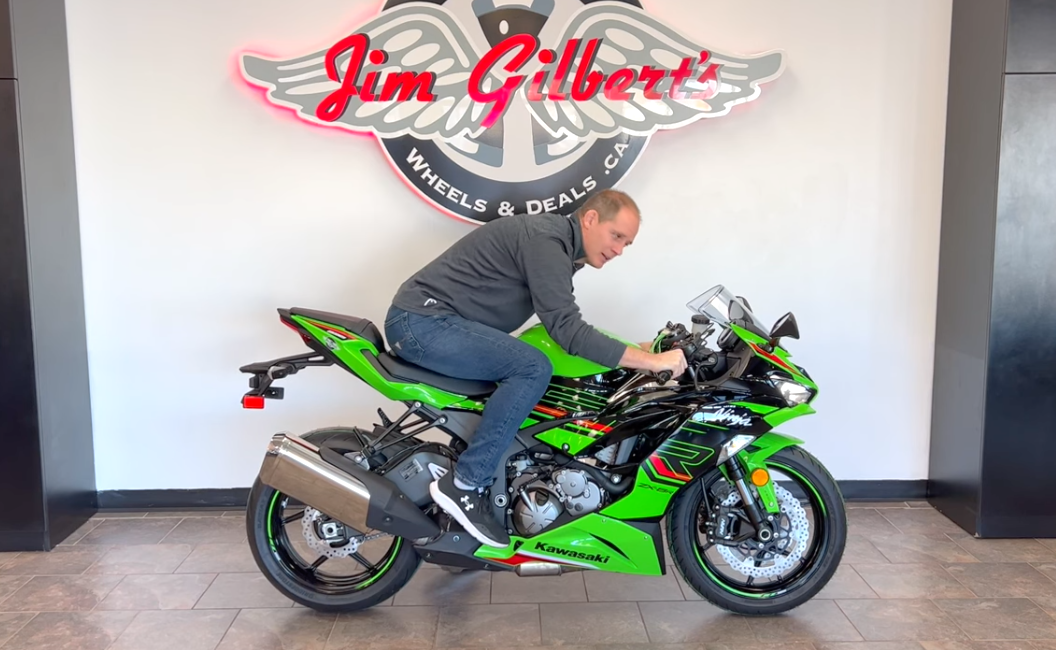
Where it gets difficult is slow speed maneuvers. And one of the reasons I don't recommend this bike for beginners is not necessarily due to its power, which is of course is something to be aware of, but if you're a relatively new rider, slow speed maneuvers, these handlebars don't turn that sharp and a different, it's a different feeling leaning over the handlebars like this in order to do those slow speed maneuvers. So it's something to consider aside from all of the, you know, power that's available here, you may have driven a powerful bike, but driving a powerful bike like this in this position can be hard. So again, the other reason I don't recommend it as a beginner bike is because it is focused, it is harder to do a variety of riding than you know you would like. The other thing you're gonna notice is your legs are tucked up nice and high.
Now for me, I don't find this bend in my leg to be at all uncomfortable. I'm quite comfortable like that, but some people are gonna find that that position is tougher on their knees or their hips or something like that. So the reason your legs are up high is cuz what makes it great for the racetrack is you can really, really lean over and if you see moto GP races where those bikes are leaned right over, that's what these are based on. This is what this comes from, you can lean this right over to touch the feeler and those pegs are really, really high. You need some skill to do that. And if you're doing that on the roads, you're probably going way, way beyond the speed limits. So again, this bike is really easy to lean back and forth for a four cylinder motorcycle. It's very lightweight, very compact, it's very fun to just easily maneuver. You know, there's a lot of things about this position that make it
Very fun but it's not gonna be the most comfortable bike. So that's something you really have to take into account. Now let's start looking at the details of this, the real tech things that really make this bike stand out. So to start with this bike, let's take a look at the dash. I'm gonna turn the key on. The key is actually off-centered here. We'll show you that a little bit uh, later. And we've got the dash in a position where I don't think there's too much glare here. Now you may be expecting a TFT display. We know that the XX four R and ZedX four RRR that were released do have a new TFT display. Obviously this one doesn't have that yet. I don't mind that too much because the way this is laid out is very clear. Now obviously Kawasaki's moving to that TFT display and that will be in view in these bikes as they uh, begin to evolve and go through next generations and that kind of thing.
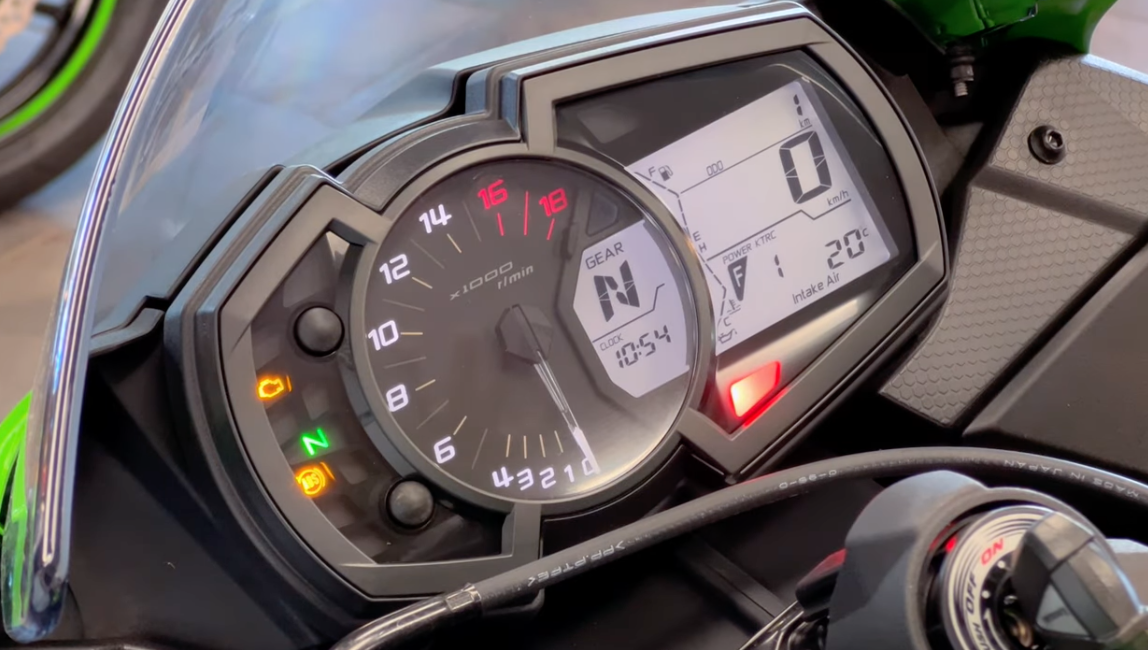
But you're not really losing anything with this here at all. So there's a selection switch on the left side handlebar that I'm gonna use to select various things. Actually, before we go there, lemme just point out before I move away from my shot here where I can see things, check out the tack. The first 4,000 RPM on this bike, they don't matter. So you'll notice that a lot of bikes put power down lower in the rev range or in the mid-range. I just bought the uh, Zed 900 Rs and a lot of that power's in that mid-range on a super sport bike, all of the power is up high and literally the first 4,000 rpm, they don't matter. You're living in six to 14, 15,000 RPM on this bike. That's where you're making your power, that's where you're driving this if you're on a track or that kind of thing.
So it's just something to keep in mind. Again, little different, little fun. So there's a selection switch. I'm gonna show you a little bit on the left side of handlebar, but I just want you to look up, up top there on, let's see, yeah, you can see that pretty clearly. So we've got the odometer there and then you have the trip A, trip B and back to odometer. So that's one selection switch, uh, on your handlebar. We'll show you the rest on the bottom, uh, handlebar or bottom switch of that switch. We'll show you that switch a second. You're now looking at this bottom section here. Right now it's measuring outside temperature, which is what they would normally say is outside temperature. But on this race bike it's the intake air. So it tells you where it's grabbing that temperature, sensing it's on the intake.
Uh, so you have a sense of the air temperature coming in, which of course helps you understand the power that this bike can make on a really hot day. It's gonna make a little bit less power than on a cool air coming in there. So intake air 21 degrees, that's our ambient temperature. Kilometers per liter is your fuel efficiency. If you care about that on this bike, you can get that. I think you can also set it to liters per hundred kilometers and that's your average. So there's an instant and oops uh, incident average down there. And then there's your range, range till empty, which of course is a calculation based on how you have been driving of how much range you have left. And then you have the uh, the temperature of your uh, the cooling temperature and then you have back to that intake air temperature.
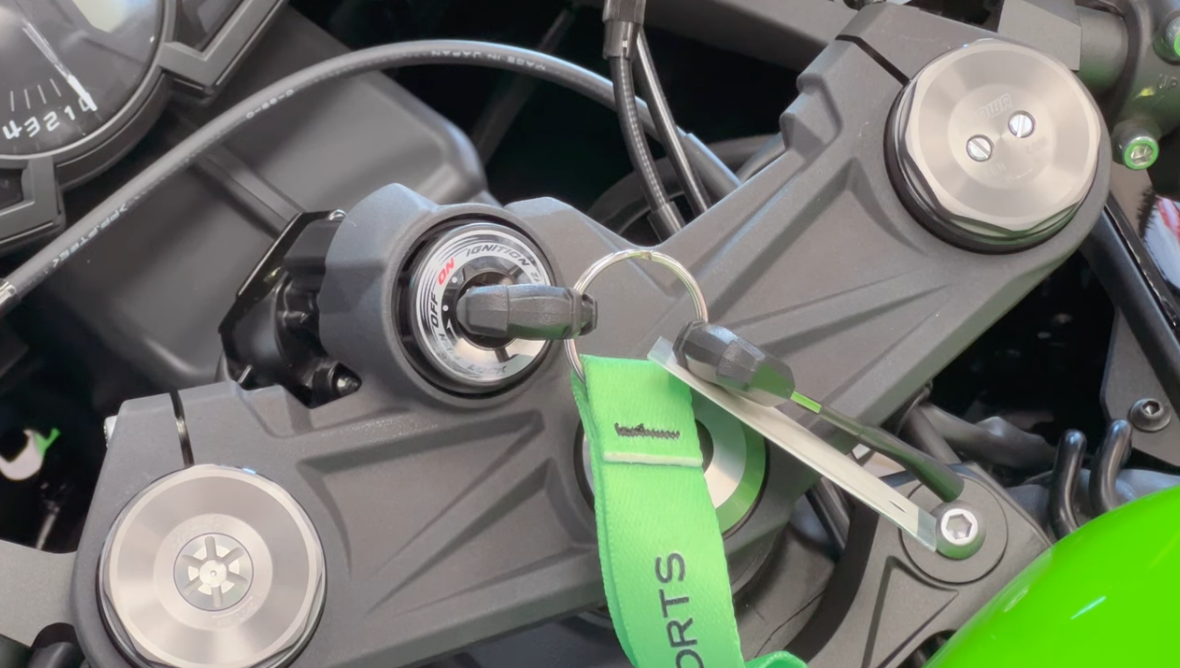
So that is the selections there. Now there's an F in here and a and A one, I don't know if you can read on your screen, depends on what you're watching on, but that um, says power and there's an F or an L. I'll show you the L in a second. And K trc. So let's talk about the power modes first. Power mode is right here. I'm gonna make it blink like that and I'm gonna select the power mode to L. So power mode is low or power mode is full. So two power modes there. You can set it to a reduced power mode. So you can, for whatever reason, whether it's raining or something else, you can set it to reduced mode or if you just want to kind of, you know, get used to riding it without having it in full power. So that is that we'll select there.
And once you selected the full or low power mode, you go to your K trc, which is Kawasaki traction control. I've done videos on how these systems work, but basically this is going to be set to off which you better know how to ride or level one or level two or on this one it has a third level there as well. So uh, some bikes have two levels. Uh, something like the, again the Z 900 Rs that I drive has two levels. This one has more levels than that. And again, in rain level three would probably be what you use. It's the highest intervention level two. Level one. I don't think I would go beyond level one if it was me on this bike, but obviously you can turn the traction control off, which you know is great for the racetrack if you really kind of know how to ride this bike better than I would be able to ride.
So we're gonna leave that on level one as well and select that. So that is your dash of course you've got your gear indicator over here, your clock, all the basics, clear speedometer and of course centrally located is that large tachometer, which again really from 6,000 to 15,000 is where you're living on this bike and getting the information you need. So we're gonna take a look at the left side handlebar right here. This is of course where your clutch lever is. Now this is a slipper and assist clutch. Now you may have heard me talk about that in bikes even down to the 400 cc Ninja or Z 400. That is a feature that started out on race bikes and it does two things for you. For the road rider, the biggest thing you're gonna notice is a little bit lighter clutch pull. Now this is no nowhere near as light as something like the ninja 400 Zed 400.
You still have a a firm clutch pull here. But what that slipper and assist clutch does is as you pull in the clutch, it's a lighter weight, which is the assist function. The slipper side of things works into the drive train and if you mess up a down shift or if you're really aggressive on the racetrack and you pop that clutch out and you know the engine really has to rev, there's a lot of engine braking. Sometimes that engine braking can cause that rear wheel to skid. So the assist part or the, yeah the slipper part, excuse me, allows that rear wheel to not slide or at least be less likely to slide. So it's both lighter at the lever here and prevents you from having a sliding rear wheel when you dump that clutch in a certain race situation or just because you screwed up the down shift on the um, you know, without rev matching on this spike.
Now that slipper and assist clutch is assisted by a quick shifter. So we're gonna talk about the quick shifter when we go around, take a look at that. But that's something to keep in mind that we'll get to you a little bit later in this video. Overall controls, you've got a little trigger shifter, right or trigger button right here that is going to flash your high beam. That's typical Kawasaki stuff. And all of this is typical Kawasaki stuff. High beams, low beams, again flashing the high beams with your trigger signal lights, horn, four-way flashers or hazard lights. And this is the selection switch. So when I selected the things on the top of the display, this is the button I was using to cycle through them at the bottom of the display. This is the button I was using to cycle through them. So that would be, you know, those temperature type things.
This would be your trip a trip B and odometer. So very intuitive. And the select switch changes your full power mode, your low power mode and your traction control. Very intuitive, very easy to use. And because of the way the dash is laid out, you just at a glance you kind of know exactly what you're doing. Some of the bikes with the TFT displays takes a little second longer to kind of guess at how it goes. You have to hold things down for rider modes and that kind of thing. And I like the simplicity of this. You want to just be driving, paying attention to where you're going. Obviously you're gonna be driving this bike quick at times and that allows you to sort of make changes on the fly and know what you're doing. The other thing I should mention is there is a little knob up here.
These levers are adjustable for reach both the clutch lever and the brake lever. So small hands, large hands, doesn't matter. You're gonna fit fine on this bike. This is a little bit of a busy visual shot given uh, everything that says behind it with the graphics and all that. But I wanna show you again little things that make a little difference. So there's that adjustment on that brake lever. Now part of this super sport is the way the brake lever actuates. So because this actuates, it actually puts down pressure down right there on your brake switch right there that allows for great feel and really precise control. Traditional bikes without this sort of sport performance type feel will pull a cable or pull something straight out here so it kind of has a different feel to it. So when you see performance bikes that push down on this right here, that's gonna give you that great lever feel and we'll show you other pieces of the brakes that kind of make it stand out from regular bikes as well down here on the handlebar, just a start button and a kill switch and that's it.
So we'll kind of leave that there. I do wanna go back to the top here though and talk about the suspension. So taking a look at the top of your fork tubes here, sort of inside of the clipon, we'll talk about that. You've got your uh, preload adjustment here, higher and lower. It tells you which way to spin that. And then you have the two adjustments here for tension and compression, t e n and compression. That's how they label them there. Uh, which allows full adjustment of the front suspension. This is an upgraded top of the line show a fork. Uh, again it's tough to show you in the um, video here exactly what they say. So I'll pop a video up here or a picture up of the left side trying to show you sort of what the lettering says here on the left side.
And we'll show another picture now on the right side showing you what the lettering looks like. There again, this allows that full suspension adjustment, which is the kind of thing you're gonna want if you're on the racetrack to tweak things here, tweak things there and it's very easy to get to. Very simple to do right at the top of the fork. While we're here, I just wanna talk about the clip-ons, which are a lot of people call them the handlebars. Obviously there's no continuous bar right across, so we don't call it a handlebar on this, it's a clip-ons. Most ninjas that you are familiar with, the ones that I have done, the road going ninjas will have clip-ons that clip up and out here. So your handlebar comes towards you and out this one is underneath and comes down and of course it's angled back that gives you that aerodynamic tuck position, but is also what contributes to making this just a little bit less comfortable than some of those more road going bikes over this. So that's kind of how that works.
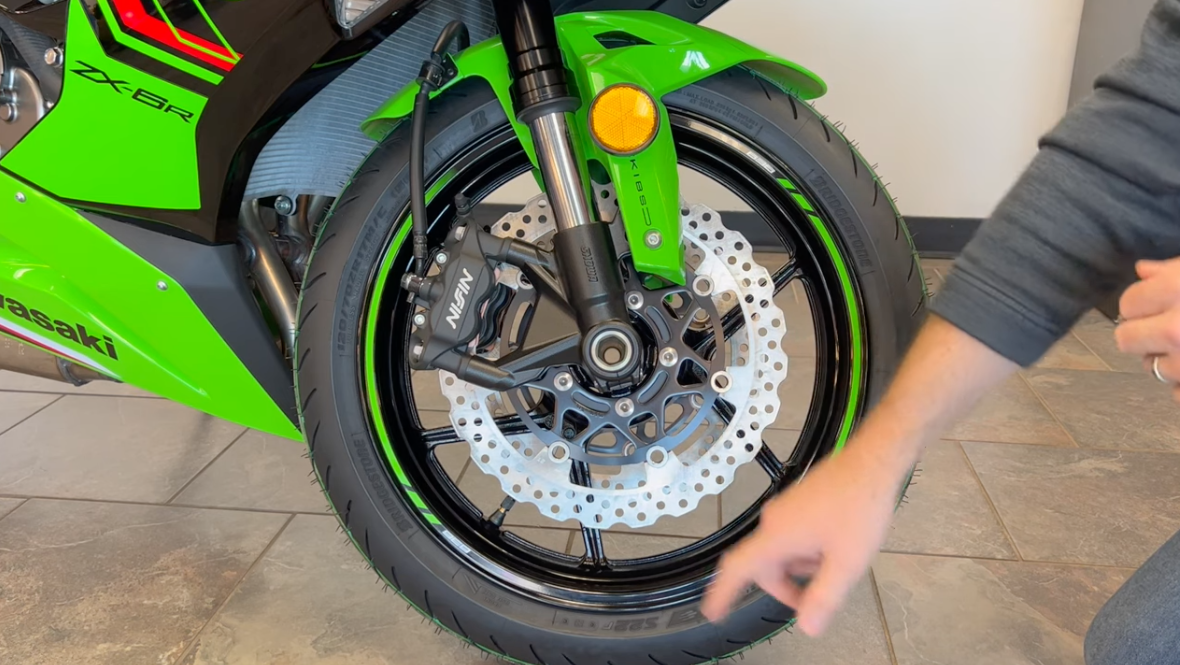 Now let's take a look at the front brakes and talk about some differences in there. So I love this view right here because it shows so much of the focus of this bike. First of all, overall design of a couple things. The suspension is an upside down fork. This allows for more stiffness up top for racing, little bit less, um, unsprung weight, which really matters in a higher performance, uh, bike as well. So that's kind of typical stuff for the class. But again, different than some road going bikes. Same thing with the way the brakes are mounted here. We talked about that handle, uh, the the um, brake lever, excuse me, the way it's designed. These are also designed different too. Your, your attachment bolts here come in from this way rather than sort of on that way gives you a little bit more precision for the road going bike.
Now let's take a look at the front brakes and talk about some differences in there. So I love this view right here because it shows so much of the focus of this bike. First of all, overall design of a couple things. The suspension is an upside down fork. This allows for more stiffness up top for racing, little bit less, um, unsprung weight, which really matters in a higher performance, uh, bike as well. So that's kind of typical stuff for the class. But again, different than some road going bikes. Same thing with the way the brakes are mounted here. We talked about that handle, uh, the the um, brake lever, excuse me, the way it's designed. These are also designed different too. Your, your attachment bolts here come in from this way rather than sort of on that way gives you a little bit more precision for the road going bike.
It's not gonna be a whole lot of difference, but it gives you overall stiffness which of course is what you want. So again, this is different, this is different. Then you look at the brakes overall. These are the pedal style brakes. Now they're moving away from some of these pedal style brakes on some of their bikes. But of course the theory is that these allow you to have a little bit extra cooling. I think it's mostly these pedal styles are just about um, style. But then of course the drilled rotors, uh, of course allow for a lot of cooling and it's not a continuous disc, which is pretty standard stuff on most. But we used to do, if you look at the old original like 1970s bikes, a single disc with no ventilation at all and we added ventilation and now this separation in here allows for this disc to expand and contract because this is absorbing heat.
And that's what these sort of spacers do in here. So you're gonna see this on high performance braking systems that you have that sort of separate um, disc from inside here. Again, all about performance and then the tires, you've got battle acts S 22, these are hyper sport tires. These are, you can already feel just putting your hands on them. These are different type of material. They're not gonna last as long as some of the more road going tires, but they give you incredible grip especially as they get a little bit warmed up. Incredible grip on both a racetrack and on the road. So everything you're looking at here is super sport, including this Gibbs Kawasaki intelligence breaking system. So this is the more advanced ABS system you can, I've done videos on that in the past as well. But like I said, everything you see here is all about super sport performance and it's just, it's super interesting to look at if you're a nerd like me.

So I'm gonna continue to geek out about the nerd stuff about this bike stuff that makes me kind of just impress with the overall technology here. So we talked about the shifter earlier, we talked about that slipper and assist clutch. Of course the one thing you need to remember is you don't need to use the clutch for anything other than essentially getting in into first gear on this bike. You can use it anytime you want but this has a quick shifter. So what a quick shifter does is literally once you are driving you can tap down or you can tap up on the gear shifter and you do not have to use the clutch. You do not have to lift off the throttle to do an upshift. So that allows for lightning quick acceleration. And the way it works is this sort of system sends us message to the engine to just cut fuel for just a split second to allow the shift to happen and then reengages automatically it is super slick to use and it makes for lightning quick upshift.
And when you hear this thing zip it along, switching through the gears, there is no clutch pull in then shift, then clutch release. You just hear the instant rev uh, dropping and going and dropping and going again. So again, up down quick shifter is a super cool thing and it's just something that I think is just makes this bike super, super fun. And of course it's a practical thing for the racetrack, it makes you faster. The other thing you're gonna see here is simply the steel um, uh, foot pegs here. Traditionally road going bikes are gonna have some level of rubber padding here to take out vibrations. But again, they add some weight, they're unnecessary on a race bike and that's why you have these sort of, you know, sharp grippy things. They will grip your uh, your riding boots. But uh, they are no, you know, no concessions to passengers.
Uh, here to comfort. This is all about uh, being race ready. Kind of another weird angle to film at here. I would be showing you sort of the air entrance here, the ram air dead in the center. So of course when you look at aerodynamics of a motorcycle, the highest pressure is at the very front leading edge down the sides. It's kind of moving to the side but right in the dead center the air's gotta go somewhere and that's where the pressure is. So having the air intake there, that sort of ram air style intake right there in the center makes a difference for adding that power at speed. Now what's interesting is it actually comes through into the frame through the center here into that frame area. This is an aluminum frame that's unique to this bike and it just allows all these things of performance.
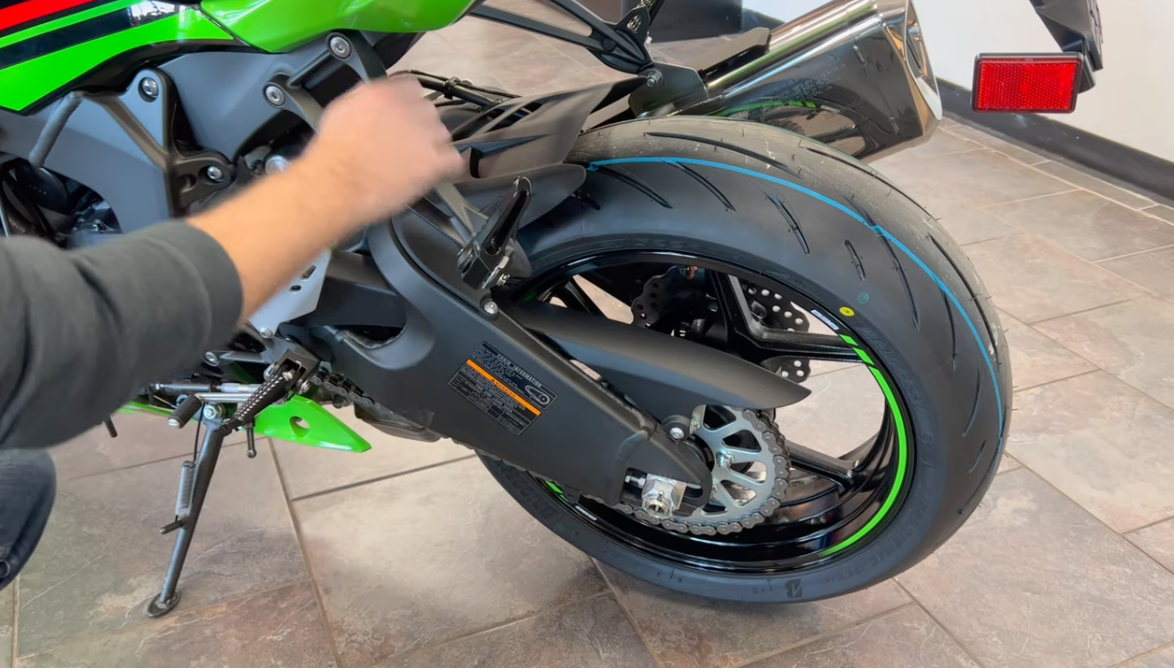
So again, ram area into here, into a really uh, unique frame for a race bike like this. All of it is built together to work seamlessly as one to both build power. And again, this frame is compact and lightweight, allowing for great handling. So really cool the way it makes power really cool the way it's sort of designed together to stay compact, safe, stay, um, nice and central to the center of this for center of gravity for better handling, really smart design. This is another view that I really kind of like just to show all sorts of different things all in one. So you do have your passenger foot bags here. Again, this is a uh, this is a bike that can be used on the street. You can take a passenger here, little bit of a tie down ring in there. So if you were tying things down to the uh, tail without going through here, most uh, modern sport bikes, you can have some sort of bag tied to this tail piece up here that can be removed, but you do have a little hook there if you wanted to.
So we'll put that up. Overall the swing arm here, again, it's all about lightweight and strength. So it's cool design and again, you can have a really good access to sea beyond here for those um, those uh, super sport tires or hyper sport, uh, Bridgestone, hyper sport type tires. Even the little uh, the fender in here. It's got some venting there cuz the wheel's gonna create some turbulence in there and allows that to come out. Allows the dirt to stay put but the air to come out. So it's just smart design and again, looking a little forward here, you do have that tucked in um, uh, suspension component, rear suspension as far forward as it can be, nice and low in the chassis. So all of the weight is down low, everything's tucked forward. Again, this thing is all about the handling at that point there.
The other thing you're gonna notice is if you look at the chain here, you can just tell by looking at this bike compared to some others, it is a little bit stronger chain than some. And that's of course cuz it's moving a lot of power through here. Taking a look at the overall bike here, again, normally I try to film with me in the shot, but again I wanna get a nice close look at the entire piece together because that's really what this bike is. Every piece works well together to make it a great bike. So your signal lights are built into the body work here. They're not all in the stalk, that's both aerodynamics, it's looks, it's a whole bunch of things. And uh, that styling of the fairing here. So of course this is aerodynamically designed, we mentioned that sort of ram air intake bringing air into there.
You've also got some areas for the heat to come out of there and it does curl in a little bit. So when your legs are tucked, tucked in here, they're also out of the wind and this is all pushing air a little bit away. So you'll still feel the wind on your legs but from an aerodynamic perspective allows you to tuck in close and keep your legs out of the wind. You can see that four-cylinder engine in there, you know, pieces of it come through the body. Work here. Again, all about lightweight. You can really see that frame coming up through here, coming up uh, in the backside as well. Single exhaust on this, on the right side. Again, the reason to do single exhaust on a super sport, one exhaust is lighter than two. So you're gonna have one the one side and that's it.
It's all about lightweight. This bike with the abs brakes weighs about 430 pounds and again, thin and compact through the middle here. It's something that I really can't emphasize enough. You have to widen around here to have the four cylinders that come out there, uh, that come in under sort of here, four cylinders laid across the width of the bike, but nice and thin through the riding position and stay thin through the tail. So the overall look here, nice and compact and that's what you want. So before I wrap up with my final, final thoughts, I just wanna point out of course this bike does have l e d headlights. Some of the kawa soggies in the past had sort of one side on and not the other with a low beam. Both sides are on, they're the bright white L e D lights and both sides are the high beam.
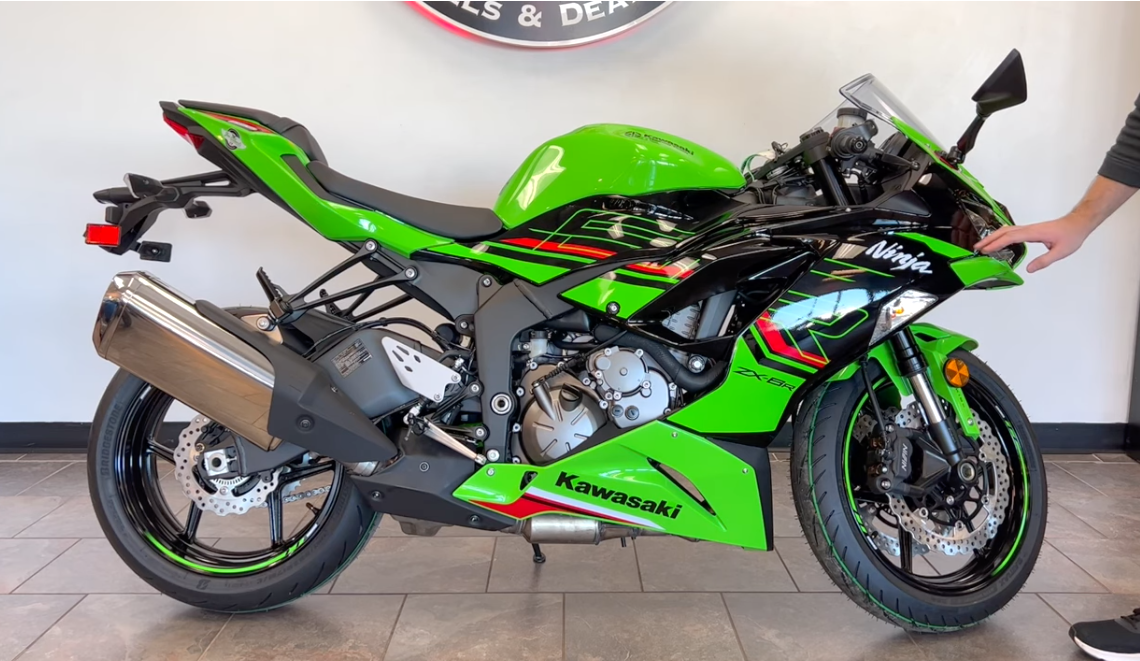
So you've got good white lights there, a good uh, instant on instant off L E D brake light there as well. So earlier in this video I talked about how this is a bike that the kind of bike that I just lusted over as a child but now will probably never buy. And I wanna be clear, I absolutely love that this bike exists and what's cool about it is on the bike that I just bought, the Z 900 Rs, it has the components that are all built for the race bike. That the cool thing about Kawasaki is all of this race technology, it works its way down into other types of bikes. So you can still have so many pieces of these bikes in other bikes in the Kawasaki lineup. This is a flagship bike and there are gonna be people that want this exact bike. But I think if we're honest with ourselves, there are features of this bike that we want. The great feeling pull from the brake levers and the different race style brake design, the upside down forks, all of those are on the bike I just bought, but I have an upright seating position. Having this bike with so much power is great high in the revs, but for most on road riding, having power a little bit
Lower in the revs makes it a little easier to drive around town. More comfortable for your country road sporting adventures instead of your well beyond legal speed racetrack adventures. So there's all kinds of things there. Things like traction control have been perfected on a bike like this to be used by us on bikes on the street, the Advanced ABS system, my current bike doesn't have that, but there are other bikes that are road going bikes that have that K I B S advanced braking system. There are so many things in this bike and it's just cool to see them all together in one. But all sorts of pieces of this are just sprinkled throughout the Kawasaki lineup and they are perfected because of this. So who is this bike for? This is not a bike for a beginner. If you wanna bike as a beginner, you should not ride this simply because the world of motorcycling opens up with different styles of bikes that maybe are more street friendly, maybe are more comfortable.
You can do different types of tours. You don't wanna be touring on this bike. And again, I know people are gonna let me know in the comments, oh, I did tour on that bike and good for you, but this isn't the best touring bike. And it's, you know, it's designed to be the best at other things and it's great at that. So this is a bike that if you get used to other bikes and want some more speed, if you get used to sport riding and want some more lean angle, want to come out of corners faster, want to go into corners later, break later, come into them faster, this is a bike that is worth moving up to. It is an iconic bike that 6 36, it was a cheater bike. It was the first 600 bike to kind of go beyond that 5 99 cc, give you the little bit extra ccs to make it an absolute blast.
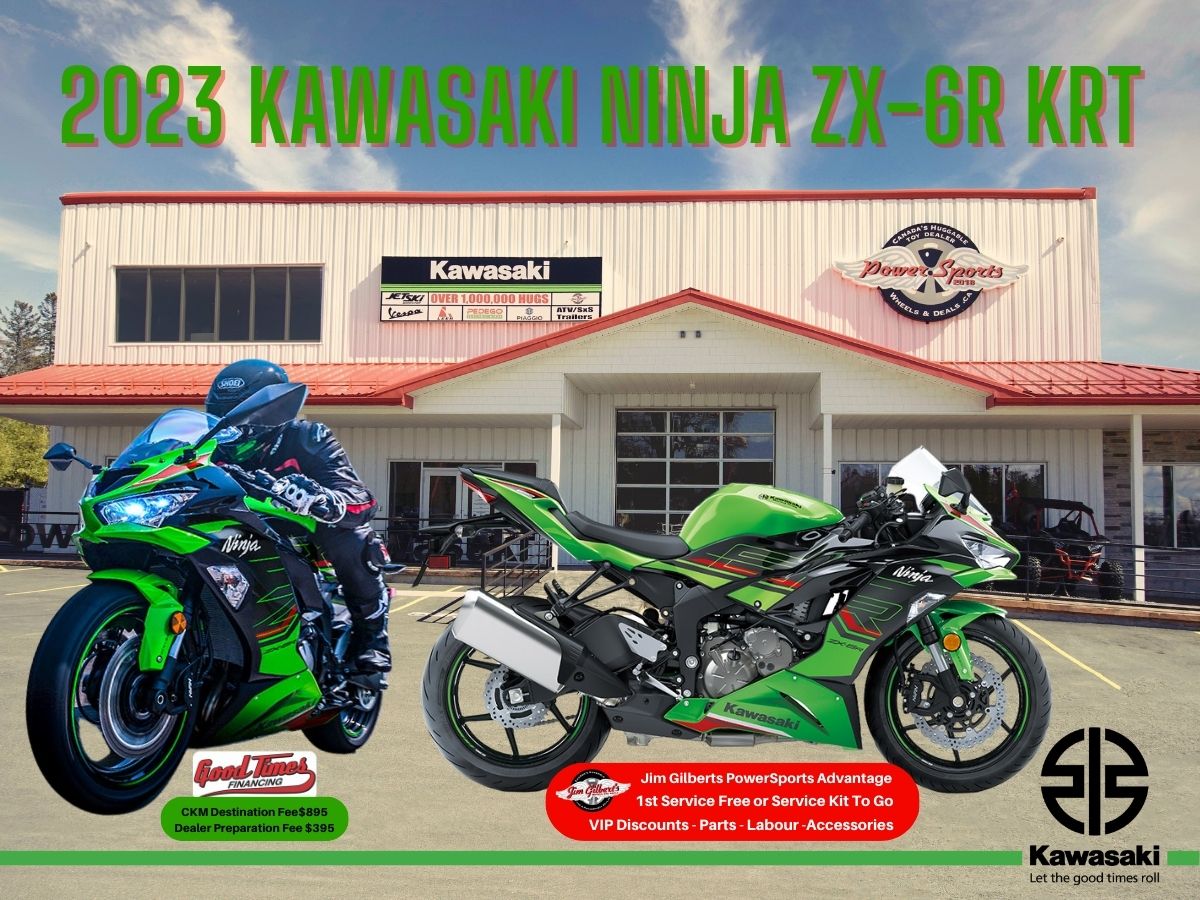
Again, this is a fully road legal race bike. It's got a firm ride. You can touch the suspension up, but it will grip through corners. It will drive quickly anywhere you wanna do. And it's like I said, all of the package is together in one and it makes it iconic. But if this isn't the bike for you and there are things you like about it, like I said, pieces of the technology, pieces of the design, frame design, all kinds of other things are things you can find in other bikes in the lineup that maybe are more suited to you. This is the pinnacle. Everything's together on one, but there may be a better bike for you out there. So let me know in this video or in the comments of this video what you want to know about this bike. It's so much fun to look at.
Obviously it'd be a blast ride. There's all kinds of riding reviews out there, which you can see this thing on the racetrack. I'm not gonna do that. My skills are not anywhere near where this bike is capable of riding. So I'm gonna continue to show you the details and talk about the details and make sense of it. If you wanna know more things, let me know when the comments below and I'll come back to this in future comments and in future videos, unless this sells. If you want buy it, it's sitting right here at Jim Gilbert's Power Sports here in Fredericton, new Brunswick. It is February right now. Bikes are selling again. I don't know if we're getting another one of these right now. This is the only one we have. So if this is one you want, come by and buy it. Thanks everybody for watching. We'll talk to you the next one.
Full Helpful Financing available..
